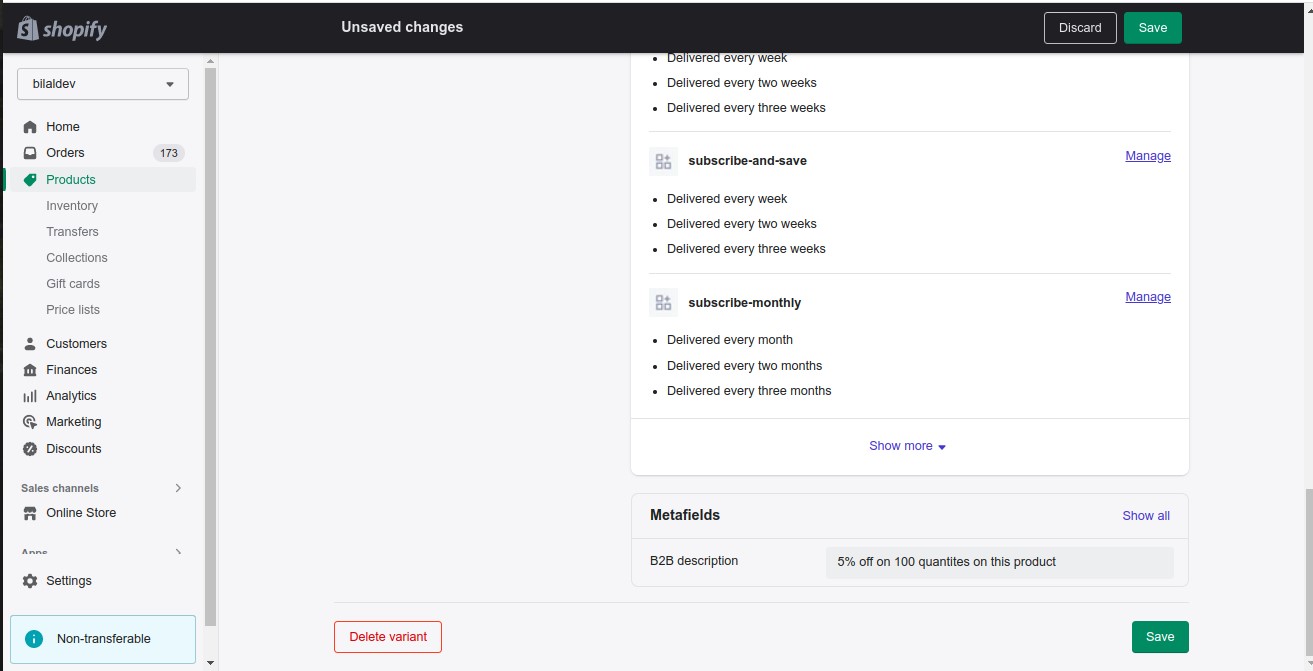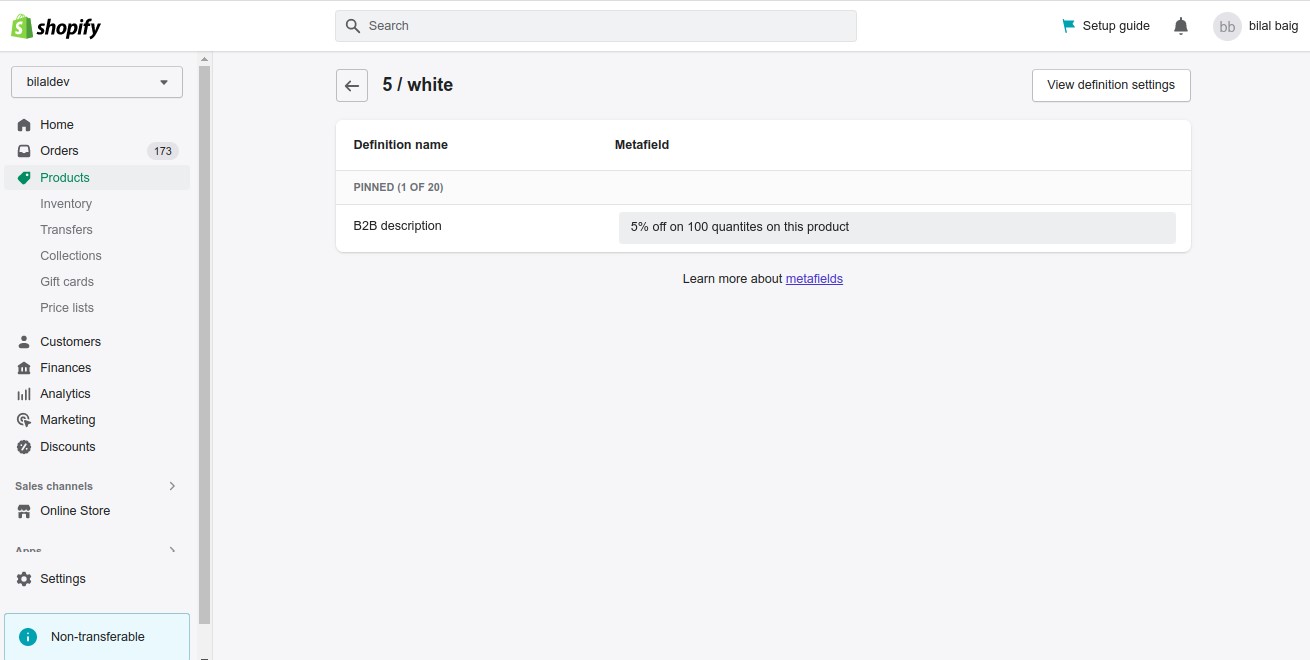Shopify Variant Metafields
Last Updated | January 16, 2024
Table of Contents
If you are a store owner, then you must be thinking of adding some versatility to your product page. Shopify variant metafileds help you in showcasing all the ranges of your products to your customers.
In this blog, we will specifically focus on product Shopify variant metafields, their benefits, uses, integration, and how to get product variant metafields + Shopify.
- Shopify hosts more than 4.5 million websites in around 175 countries.
- Shopify’s app store is vast, with more than 7 thousand apps available at the touch of your hand.
- Most Shopify Plus website owners find the Shopify Variant Metafields useful.
What Is A Metafield?
A Metafield is a way to add information to your store that isn’t included in the standard Shopify configuration. The most popular are Product Metafield and Shopify liquid variant metafields. It will enable us to display more details about each product on the product page. Adding tailored Metafields is now built into Shopify.
What is the difference between Metafields and Metaobjects in Shopify?
| Aspect | Metafields | Metaobjects |
|---|---|---|
| Definition | Customizable pieces of data associated with specific Shopify entities (e.g., products, variants, collections). | Objects used to create and manage custom data structures, which can be associated with various Shopify entities. |
| Granularity | Store-specific data tied to individual entities. | More complex, structured data with relationships between objects. |
| Use Cases | – Adding extra information to products (e.g., product dimensions, custom descriptions). | – Creating custom data structures, e.g., a recipe with ingredients and instructions. |
| Flexibility | Flexible for adding extra fields to Shopify entities without changing their core schema. | Offers more complex data modeling, allowing you to define your own data structures and relationships. |
| Relationship | Metafields are associated with a single entity (e.g., a product) and can be accessed directly from that entity. | Metaobjects can be linked to multiple entities and are retrieved and manipulated through the GraphQL Admin API. |
| Access and Retrieval | Accessed via Shopify Admin, REST Admin API, or Liquid templates. | Accessed through the GraphQL Admin API. |
| Examples | – Adding a “manufacturer” field to a product. | – Creating a custom data structure for a product recipe with ingredients and instructions. |
| Data Type Constraints | Limited data types (e.g., text, number, JSON). | More extensive data types with custom-defined schemas. |
| Integration Complexity | Relatively straightforward to implement and manage. | More complex, typically requiring custom GraphQL queries and mutations for integration. |
| Storefront Availability | Data can be displayed in the storefront using Liquid templates. | Typically not intended for direct display in the storefront, primarily used for custom app development or internal data management. |
In summary, Metafields are simple custom data fields that can be added to Shopify entities, while Metaobjects allow for more complex data modeling and relationships, primarily accessed through the GraphQL Admin API. The choice between Metafields and Metaobjects depends on your specific use case and the complexity of the data you need to manage in your Shopify store.
Read Also: Bigcommerce GraphQL Explorer
What are Product Variants in Shopify?
Product variants refer to different versions of a product that have unique characteristics, such as size, color, or material. In Shopify store development, product variants play an important role in creating a seamless shopping experience for customers.
The ability to manage and track different variants of a product is crucial for merchants. This is where Shopify app development and Shopify integration come into play, as they provide the necessary tools and functionalities to manage product variants easily.
For example, a Shopify migration app could help a merchant seamlessly transfer their product variants data from one platform to Shopify. This streamlines the store setup process and allows merchants to focus on other important aspects of their business.
Keep reading to learn a step-by-step guide on Shopify how to add custom variant metafields.
Step By Step Guide – Product Shopify variant Metafileds
Below are the steps on Shopify on how to add custom metafields for variants:
Step Number 1: Head to Variants
Go to settings -> metafields -> variants -> click add definition.
Step Number 2: Add Data in Fields
Add name and description (Namespace and the key would be auto-populated)
Step Number 3: Select Content Type
Select content type based on your metafield type, multi-line text in our case.
Step Number 4: Add validation rules, if any, and save
Using four simple steps, you can add metafields to your product variant.
Now how can you add value to your product variant metafields
Step 1: Go to the Products listing page -> select product, and -> Scroll down to the variants section and -> select variants
Step 2: On the variant page, scroll down to the bottom ‘Metafields’ section
Step 3: Click Show all and add value to your respective metafield and Click Save Button
By following the above 3 simple steps, you can add value to your metafields
Display Metafild on the product page
Now if you want to show the metafield on your product page, there is a code for showing variant metafields on Shopify. Follow the steps below to know how to display variant metafields + Shopify.
Step 1 for Shopify Theme Customization: Head to Online store -> Themes -> customize
Step 2: Select the product page from the middle selection bar.
Step 3: Click on Add block -> Custom liquid block.
Step 4: In the custom liquid copy code block below
{% for variant in product.variants %}
{% if product.selected_or_first_available_variant.id == variant.id %}
<strong>B2B Description: {{variant.metafields.custom.b2b_description}}!</strong>
{% endif %}
{% endfor %}
<script src="https://ajax.googleapis.com/ajax/libs/jquery/3.5.1/jquery.min.js"></script>
<script type="text/javascript">
jQuery(document).ready(function($){
$(".no-js-hidden").on("click", function(){
var refreshint = setInterval(function(){
location.reload();
}, 1000); }); });
</script>
This step can get a little complicated; hence, it is recommended to Hire Shopify Developers or a Shopify Custom development company for this whole integration.
Step 5: Copy the variant metafield code from settings ->metafield and replace it in the code.
Variant.metafields.custom.b2b_description
Read Also Shopify Variant Metafields
Step 6: Click save and preview the theme after navigating to the product. If you have also created a query view metafields for variant Shopify, you’ll be able to see that here as well.
You will need Shopify variant metafields API to edit variant metafields Shopify.
Benefits of A Shopify Variant Metafields
Following are the benefits of Shopify variant metafields:
Improved Product Management
Variant metafields Shopify allows you to add specific information to each variant of a product, such as weight, color, or manufacturer. This can help you keep track of your inventory management and manage your products more effectively.
With this information readily available, you can quickly see which variants are in stock, out of stock, or low in stock.
Additionally, you can use this information to optimize your purchasing decisions by tracking which variants are selling well and which ones are not.
Better Customer Experience
By adding Shopify variant metafields to your product pages, you can provide customers with more information about each variant. For example, you can include detailed product descriptions, size charts, or images specific to each variant.
This additional information can help customers make more informed purchasing decisions, leading to increased customer satisfaction and reduced returns.
Additionally, providing customers with more information about each variant can help them feel more confident in their purchase, leading to increased sales and repeat business.
Increased Sales
By providing customers with more information about each variant of a product, you can increase the likelihood of sales. When customers have all the information they need to make an informed decision, they are more likely to complete a purchase. This can lead to increased sales and revenue for your business.
Customization
Shopify variant metafields are highly customizable, allowing you to add any type of information you want to each variant. This flexibility allows you to tailor your meta fields to meet the specific needs of your business.
For example, if you sell clothing, you can add information about the fabric content or care instructions for each variant. If you sell jewelry, you can add information about the metal or gemstone used in each piece.
Integration with Other Apps
Shopify’s Shopify variant metafields can be integrated with other Shopify apps, allowing you to use the information stored in meta fields in other parts of your store.
You can use Shopify variant metafields in conjunction with a product filtering app to create custom filters for your customers. This can make it easier for customers to find the products they are looking for, leading to increased sales and a better overall customer experience.
Uses of Shopify Variant Metafield
Following is the list of uses for Shopify variant metafields:
Product Descriptions
Product descriptions are a crucial part of any product page. By using Shopify variant metafields, merchants can provide customers with detailed information about each variant of a product, including features, benefits, and specifications.
This can help customers make more informed purchasing decisions and increase their confidence in their purchases. Additionally, by providing customers with more information about each variant, merchants can reduce the likelihood of returns due to product dissatisfaction.
Size Charts
Size charts are particularly important for products that come in different sizes, such as clothing, shoes, or accessories. By using variant metafields, merchants can provide customers with detailed size charts for each variant, helping them choose the right size for them.
This can reduce the likelihood of returns due to incorrect sizing and improve the overall shopping experience for customers.
Images
Images are an important part of any product page and can have a significant impact on the likelihood of a sale. By using Shopify variant metafields, merchants can display different images for each variant of a product, allowing customers to see exactly what they are purchasing.
This can help customers make more informed purchasing decisions and improve the overall shopping experience.
Shipping Information
Shipping information is an important part of any product page, as it can have a significant impact on the likelihood of a sale. By using Shopify variant metafields to add information about the weight or dimensions of each variant, merchants can calculate shipping costs and display them to customers on the product page.
This can help customers make more informed purchasing decisions and reduce the likelihood of abandoned carts due to unexpected shipping costs.
Product Upsells
Product upsells are a great way to increase sales and improve the overall shopping experience for customers. By using Shopify variant metafields to add information about complementary products, merchants can suggest related products to customers and upsell them.
This can help merchants increase their average order value, revenue and improve the overall customer experience.
Conclusion – Shopify variant metafields
Shopify variant metafield can excel your product page by enhancing some usability and accessibility to it. It is always recommended to add these metafields for the ease of customers. In this blog, we told you exactly how to do it and enhance the variant metafields according to your need.
Channel this superpower of your store and get the best out of Shopify. If you are struggling to enable it, then our Shopify development company can help you, or you can simply look out to Hire Shopify Experts.





















